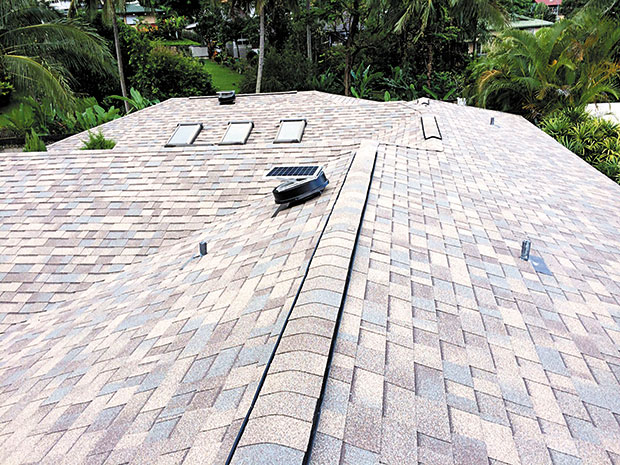The local perspective on asphalt shingles

Part two of a two-part series
Last week, Surface Shield Roofing Co. explored the perspective of ARMA’s (Asphalt Roofing Manufacturer’s Association) viewpoint on asphalt shingles. Local material distributors, roofing industry opinion leaders and a well-known asphalt shingle manufacturer representative shared a similar viewpoint as ARMA, however, brought up additional warnings to consumers who intend to coat their asphalt shingle roofing system.
Local owner of All Weather Surfaces Keith Adams chimed in on the debate, in which he stated, “Though nearly ever professional roof coating manufacturer strictly disapproves the use of their FARC (Fluid- Applied Roof Coating) over asphalt shingle roofs, there are some that still sell it specifically for that purpose. The issue with unreinforced fluid-applied roof coatings being applied to shingle roofs, and the reason they so often fail, is directly related to the gross amount of over-lapping seams on that roof surface. In roofing, seams are our enemy, as 99 percent of any water intrusion into the dwelling will happen over a seam or penetration, particularly one that isn’t fabric reinforce( d).”
When looking at a normal SBS Roll Roofing (granulated cap sheet), there is approximately 12 inches of seam left exposed for every 3 square feet of cap sheet. That same 3 square feet of an asphalt shingle roof has approximately 72 inches of exposed seam, providing over 600 percent more chance of the roof developing a leak when coated with any roof coating, regardless of type. With that said, it is very easy to see why the vast majority of fluid-applied roofing manufacturers will never recommend their coating for application to an asphalt shingle roof. If they won’t recommend it, why would you install it, is the question?
Seam exposure is one of the leading reasons Surface Shield does not utilize this installation practice, because once a seam is exposed, it allows for water penetration, which could ultimately lead to the rotting of your roofing structure/substrate. The best practice would be to replace or reroof with an energy-efficient shingle. Up front, the cost could be more, but if your roof deck rots because of water intrusion, you are looking at more than it would have originally cost you just to reroof.
Roofing Contractors Association of Hawaii’s executive director Tim Lyons also was in alignment with ARMA’s perspective. “Based on information available to the Roofing Contractors Association of Hawaii, we cannot recommend the practice of applying coatings over asphalt shingles after installation. This is a practice where certainly the homeowner (roof user) needs to obtain manufacturer pre-approval in order to avoid possible subsequent problems. We are not aware of any shingle manufacturer specification or literature that approves of this procedure. We have not seen any documentation that demonstrates benefits to this practice.”
“I am not a big fan of fluid applied roofing,” said Joshua Wallwork, territory regional representative for Certain Teed Roofing Co. , who was in alignment with ARMA. “However, if you are going to do it, do it right. Over shingles is a very bad idea; it should be done with fabric and proper adhesion to substrate. No way that is possible over shingles.”
Overall, homeowners should be aware of the risks involved when deciding to coat their asphalt shingles. Do research, then decide for yourself. Weighing the pros and cons of coating asphalt shingles seems to have more cons than pros.
Surface Shield Roofing Co. is a full-service roofing company, offering the installation of metal, shingle, tile and silicone coating systems. Its highly trained staff provides homeowners with various options that will best suit their roofing needs, equally in both budget and aesthetics. Call the company today for a free estimate at 739-9599.
SURFACE SHIELD ROOFING CO.
contact // 739-9599
web // surfaceshieldroofing.com
email // surfaceshield@hawaii.rr.com